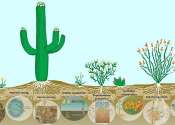Mighty microbes: Soil microorganisms are combating desertification
Desertification is a significant problem for arid, semi-arid and dry sub-humid regions of Earth, whereby grasslands and shrublands become a comparatively barren desert as vegetation disappears over time. This poses an extreme ...









